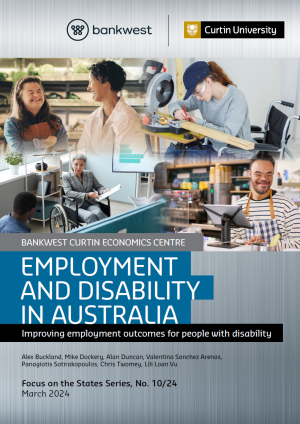Working Papers
Trust a few: natural disasters and the formation of trust in Africa
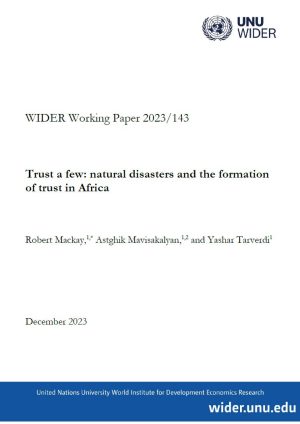 Individuals are at their most mental plasticity in their impressionable years (ages 18–25 years) forming long-term attitudes and behaviours essential to functioning in a society, such as trust. In this paper we ask how exposure to natural disasters within the... Read article
Individuals are at their most mental plasticity in their impressionable years (ages 18–25 years) forming long-term attitudes and behaviours essential to functioning in a society, such as trust. In this paper we ask how exposure to natural disasters within the... Read article
 Individuals are at their most mental plasticity in their impressionable years (ages 18–25 years) forming long-term attitudes and behaviours essential to functioning in a society, such as trust. In this paper we ask how exposure to natural disasters within the... Read article
Individuals are at their most mental plasticity in their impressionable years (ages 18–25 years) forming long-term attitudes and behaviours essential to functioning in a society, such as trust. In this paper we ask how exposure to natural disasters within the... Read article
Mining and mistrust in government
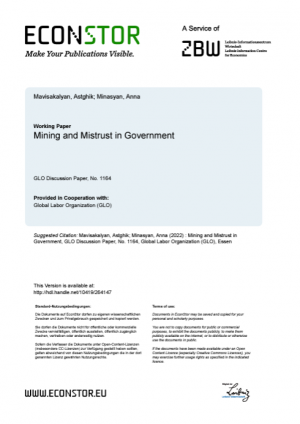 Recent research shows that natural resources can hurt institutions by promoting corruption and diverting resources from the production of public goods. This, in turn, may have implications for the trust individuals hold for their governments. We explore this possibility by... Read article
Recent research shows that natural resources can hurt institutions by promoting corruption and diverting resources from the production of public goods. This, in turn, may have implications for the trust individuals hold for their governments. We explore this possibility by... Read article
 Recent research shows that natural resources can hurt institutions by promoting corruption and diverting resources from the production of public goods. This, in turn, may have implications for the trust individuals hold for their governments. We explore this possibility by... Read article
Recent research shows that natural resources can hurt institutions by promoting corruption and diverting resources from the production of public goods. This, in turn, may have implications for the trust individuals hold for their governments. We explore this possibility by... Read article
Gendered language and gendered violence
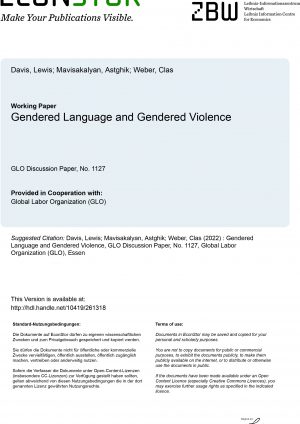 This study establishes the influence of sex-based grammatical gender on gendered violence. We demonstrate a statistically significant relationship between gendered language and the incidence of intimate partner violence in a cross-section of countries. Motivated by this evidence, we conduct an... Read article
This study establishes the influence of sex-based grammatical gender on gendered violence. We demonstrate a statistically significant relationship between gendered language and the incidence of intimate partner violence in a cross-section of countries. Motivated by this evidence, we conduct an... Read article
 This study establishes the influence of sex-based grammatical gender on gendered violence. We demonstrate a statistically significant relationship between gendered language and the incidence of intimate partner violence in a cross-section of countries. Motivated by this evidence, we conduct an... Read article
This study establishes the influence of sex-based grammatical gender on gendered violence. We demonstrate a statistically significant relationship between gendered language and the incidence of intimate partner violence in a cross-section of countries. Motivated by this evidence, we conduct an... Read article
Identity and support for policies towards Indigenous people
 This paper adds to knowledge on the role of politicians’ and voters’ identities in influencing policy-making in societies marked by ethnic inequality. The outcome we investigate is the initiatives and policies targeting Indigenous populations in the context of Australia. We... Read article
This paper adds to knowledge on the role of politicians’ and voters’ identities in influencing policy-making in societies marked by ethnic inequality. The outcome we investigate is the initiatives and policies targeting Indigenous populations in the context of Australia. We... Read article
 This paper adds to knowledge on the role of politicians’ and voters’ identities in influencing policy-making in societies marked by ethnic inequality. The outcome we investigate is the initiatives and policies targeting Indigenous populations in the context of Australia. We... Read article
This paper adds to knowledge on the role of politicians’ and voters’ identities in influencing policy-making in societies marked by ethnic inequality. The outcome we investigate is the initiatives and policies targeting Indigenous populations in the context of Australia. We... Read article
Changing demand for STEM skills in Australia and gender implications
 A method is developed for measuring the intensity with which skills in science, technology, engineering and mathematics (STEM) are used in different occupations based on workers’ field of qualification and weighted by the wage premium associated with their level of... Read article
A method is developed for measuring the intensity with which skills in science, technology, engineering and mathematics (STEM) are used in different occupations based on workers’ field of qualification and weighted by the wage premium associated with their level of... Read article
 A method is developed for measuring the intensity with which skills in science, technology, engineering and mathematics (STEM) are used in different occupations based on workers’ field of qualification and weighted by the wage premium associated with their level of... Read article
A method is developed for measuring the intensity with which skills in science, technology, engineering and mathematics (STEM) are used in different occupations based on workers’ field of qualification and weighted by the wage premium associated with their level of... Read article
Female autonomy in household decision-making and intimate partner violence: Evidence from Pakistan
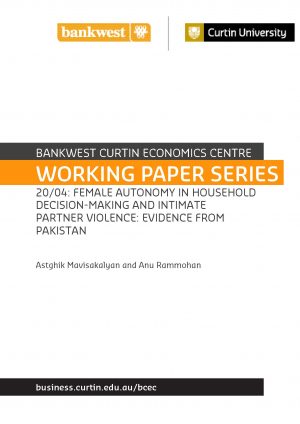 The aim of this study is to explore the links between female autonomy in household decision-making and intimate partner violence in a highly relevant yet under-studied context: Pakistan. Using a nationally representative dataset, and employing matching and partial identification estimation... Read article
The aim of this study is to explore the links between female autonomy in household decision-making and intimate partner violence in a highly relevant yet under-studied context: Pakistan. Using a nationally representative dataset, and employing matching and partial identification estimation... Read article
 The aim of this study is to explore the links between female autonomy in household decision-making and intimate partner violence in a highly relevant yet under-studied context: Pakistan. Using a nationally representative dataset, and employing matching and partial identification estimation... Read article
The aim of this study is to explore the links between female autonomy in household decision-making and intimate partner violence in a highly relevant yet under-studied context: Pakistan. Using a nationally representative dataset, and employing matching and partial identification estimation... Read article
Household density and children’s wellbeing in Australia: Are children’s homes too empty?
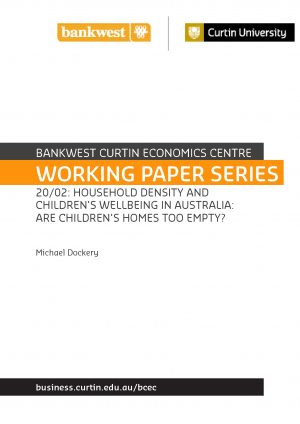 Living in crowded housing has been associated with poorer physical and mental health outcomes, with a greater emphasis on the psychological effects when the underlying quality of housing is high. Hence ‘overcrowding’ features as a housing condition extensively studied in... Read article
Living in crowded housing has been associated with poorer physical and mental health outcomes, with a greater emphasis on the psychological effects when the underlying quality of housing is high. Hence ‘overcrowding’ features as a housing condition extensively studied in... Read article
 Living in crowded housing has been associated with poorer physical and mental health outcomes, with a greater emphasis on the psychological effects when the underlying quality of housing is high. Hence ‘overcrowding’ features as a housing condition extensively studied in... Read article
Living in crowded housing has been associated with poorer physical and mental health outcomes, with a greater emphasis on the psychological effects when the underlying quality of housing is high. Hence ‘overcrowding’ features as a housing condition extensively studied in... Read article
Paradise Postponed: Future Tense and Religiosity
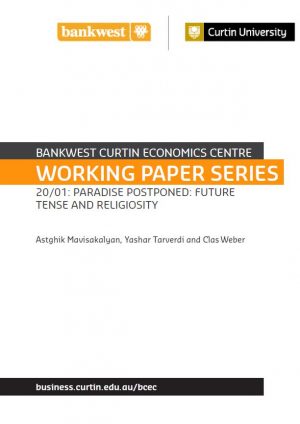 This paper identifies a new source of differences in religiosity: the presence of future tense marking in language. We argue that the rewards and punishments that incentivise religious behaviour are less effective for speakers of languages that contain future tense... Read article
This paper identifies a new source of differences in religiosity: the presence of future tense marking in language. We argue that the rewards and punishments that incentivise religious behaviour are less effective for speakers of languages that contain future tense... Read article
 This paper identifies a new source of differences in religiosity: the presence of future tense marking in language. We argue that the rewards and punishments that incentivise religious behaviour are less effective for speakers of languages that contain future tense... Read article
This paper identifies a new source of differences in religiosity: the presence of future tense marking in language. We argue that the rewards and punishments that incentivise religious behaviour are less effective for speakers of languages that contain future tense... Read article
Can bribery buy health? Evidence from post-communist countries
 Corruption is pervasive, but we know little about its effects on individual lives. This paper examines whether living in a corrupt society has deleterious effects on health. Using individual-level data from 28 post-communist countries, we demonstrate that bribing for public... Read article
Corruption is pervasive, but we know little about its effects on individual lives. This paper examines whether living in a corrupt society has deleterious effects on health. Using individual-level data from 28 post-communist countries, we demonstrate that bribing for public... Read article
 Corruption is pervasive, but we know little about its effects on individual lives. This paper examines whether living in a corrupt society has deleterious effects on health. Using individual-level data from 28 post-communist countries, we demonstrate that bribing for public... Read article
Corruption is pervasive, but we know little about its effects on individual lives. This paper examines whether living in a corrupt society has deleterious effects on health. Using individual-level data from 28 post-communist countries, we demonstrate that bribing for public... Read article
The unintended consequences of increasing returns to scale in geographical economics
 Increasing returns to scale is now fundamental to both economics and economic geography. But first generation theories of endogenous growth imply an empirically-refuted scale effect. This scale effect and assumptions to negate the scale effect both imply unintentional spatial consequences.... Read article
Increasing returns to scale is now fundamental to both economics and economic geography. But first generation theories of endogenous growth imply an empirically-refuted scale effect. This scale effect and assumptions to negate the scale effect both imply unintentional spatial consequences.... Read article
 Increasing returns to scale is now fundamental to both economics and economic geography. But first generation theories of endogenous growth imply an empirically-refuted scale effect. This scale effect and assumptions to negate the scale effect both imply unintentional spatial consequences.... Read article
Increasing returns to scale is now fundamental to both economics and economic geography. But first generation theories of endogenous growth imply an empirically-refuted scale effect. This scale effect and assumptions to negate the scale effect both imply unintentional spatial consequences.... Read article
A multi-sector model of relatedness, growth and industry clustering
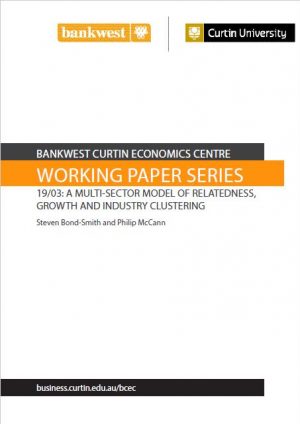 This article builds an understanding of regional innovation specialization by developing a multi-sector model with endogenous growth through quality improving innovations and spillovers from related technologies. The model provides an approach to incorporate the relatedness literature within the mainstream theoretical... Read article
This article builds an understanding of regional innovation specialization by developing a multi-sector model with endogenous growth through quality improving innovations and spillovers from related technologies. The model provides an approach to incorporate the relatedness literature within the mainstream theoretical... Read article
 This article builds an understanding of regional innovation specialization by developing a multi-sector model with endogenous growth through quality improving innovations and spillovers from related technologies. The model provides an approach to incorporate the relatedness literature within the mainstream theoretical... Read article
This article builds an understanding of regional innovation specialization by developing a multi-sector model with endogenous growth through quality improving innovations and spillovers from related technologies. The model provides an approach to incorporate the relatedness literature within the mainstream theoretical... Read article
The decades-long dispute over scale effects in the theory of economic growth
 The so-called ‘new growth theory’ is characterized by the now Nobel Prize winning insight that ideas are a non-rival input to and output from endogenous investment in innovation. Non-rivalry implies increasing returns to scale, but this also unintentionally creates an... Read article
The so-called ‘new growth theory’ is characterized by the now Nobel Prize winning insight that ideas are a non-rival input to and output from endogenous investment in innovation. Non-rivalry implies increasing returns to scale, but this also unintentionally creates an... Read article
 The so-called ‘new growth theory’ is characterized by the now Nobel Prize winning insight that ideas are a non-rival input to and output from endogenous investment in innovation. Non-rivalry implies increasing returns to scale, but this also unintentionally creates an... Read article
The so-called ‘new growth theory’ is characterized by the now Nobel Prize winning insight that ideas are a non-rival input to and output from endogenous investment in innovation. Non-rivalry implies increasing returns to scale, but this also unintentionally creates an... Read article
Explaining the evolution of ethnicity differentials in academic achievements: The role of time investments
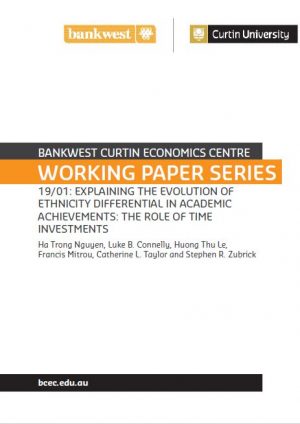 Children of Asian immigrants in most English-speaking destinations have better academic outcomes, yet the underlying causes of their advantages are under-studied. We employ panel time-use diaries by two cohorts of children observed over a decade to present new evidence that... Read article
Children of Asian immigrants in most English-speaking destinations have better academic outcomes, yet the underlying causes of their advantages are under-studied. We employ panel time-use diaries by two cohorts of children observed over a decade to present new evidence that... Read article
 Children of Asian immigrants in most English-speaking destinations have better academic outcomes, yet the underlying causes of their advantages are under-studied. We employ panel time-use diaries by two cohorts of children observed over a decade to present new evidence that... Read article
Children of Asian immigrants in most English-speaking destinations have better academic outcomes, yet the underlying causes of their advantages are under-studied. We employ panel time-use diaries by two cohorts of children observed over a decade to present new evidence that... Read article
Discretely innovating: The effect of limited market contestability on innovation and growth
 This paper considers the impact of market contestability on innovation and growth. To examine this discrete entry (i.e. an integer number of firms) is used as a tool to vary contestability in each sector of a disaggregated multi-sector endogenous growth... Read article
This paper considers the impact of market contestability on innovation and growth. To examine this discrete entry (i.e. an integer number of firms) is used as a tool to vary contestability in each sector of a disaggregated multi-sector endogenous growth... Read article
 This paper considers the impact of market contestability on innovation and growth. To examine this discrete entry (i.e. an integer number of firms) is used as a tool to vary contestability in each sector of a disaggregated multi-sector endogenous growth... Read article
This paper considers the impact of market contestability on innovation and growth. To examine this discrete entry (i.e. an integer number of firms) is used as a tool to vary contestability in each sector of a disaggregated multi-sector endogenous growth... Read article
The impact of compatibility on innovation in markets with network effects
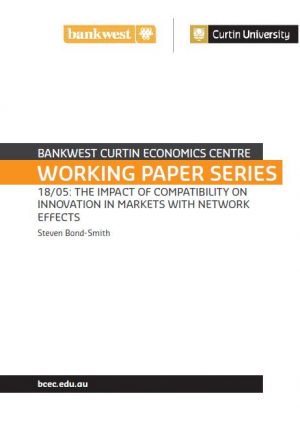 This article analyses the relationship between compatibility and innovation in markets with network effects using a model of competition with endogenous R&D, commercialization and compatibility. Incumbent acquisition of an innovation or profit from entry provides entrepreneurs with an incentive for... Read article
This article analyses the relationship between compatibility and innovation in markets with network effects using a model of competition with endogenous R&D, commercialization and compatibility. Incumbent acquisition of an innovation or profit from entry provides entrepreneurs with an incentive for... Read article
 This article analyses the relationship between compatibility and innovation in markets with network effects using a model of competition with endogenous R&D, commercialization and compatibility. Incumbent acquisition of an innovation or profit from entry provides entrepreneurs with an incentive for... Read article
This article analyses the relationship between compatibility and innovation in markets with network effects using a model of competition with endogenous R&D, commercialization and compatibility. Incumbent acquisition of an innovation or profit from entry provides entrepreneurs with an incentive for... Read article
The role of conflict in sex discrimination: The case of missing girls
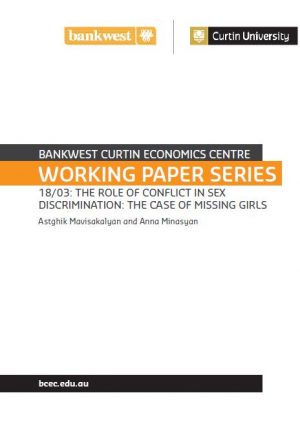 Recent evidence shows that highly skewed sex ratios at birth are observed not only in China and India, but also for a number of countries in the Southeast Europe and South Caucasus – a region that has seen eruptions of... Read article
Recent evidence shows that highly skewed sex ratios at birth are observed not only in China and India, but also for a number of countries in the Southeast Europe and South Caucasus – a region that has seen eruptions of... Read article
 Recent evidence shows that highly skewed sex ratios at birth are observed not only in China and India, but also for a number of countries in the Southeast Europe and South Caucasus – a region that has seen eruptions of... Read article
Recent evidence shows that highly skewed sex ratios at birth are observed not only in China and India, but also for a number of countries in the Southeast Europe and South Caucasus – a region that has seen eruptions of... Read article
Where do immigrants settle? Assessing the role of immigration policies
 This paper compares immigration flows in response to changes in labour market conditions to provide an assessment of Australia’s selective immigration policies. We find employer sponsored immigration varied in line with changes in regional wages, with immigrants being drawn to... Read article
This paper compares immigration flows in response to changes in labour market conditions to provide an assessment of Australia’s selective immigration policies. We find employer sponsored immigration varied in line with changes in regional wages, with immigrants being drawn to... Read article
 This paper compares immigration flows in response to changes in labour market conditions to provide an assessment of Australia’s selective immigration policies. We find employer sponsored immigration varied in line with changes in regional wages, with immigrants being drawn to... Read article
This paper compares immigration flows in response to changes in labour market conditions to provide an assessment of Australia’s selective immigration policies. We find employer sponsored immigration varied in line with changes in regional wages, with immigrants being drawn to... Read article
Rain, Rain, Go Away: Weather and children’s time allocation
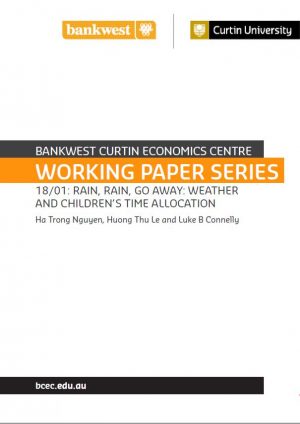 This paper presents the first robust causal estimates of the effect of weather on the allocation of children’s time. It uses individual-level data from over 45,000 time-use diaries of children from two nationally representative cohorts of Australian children whose time-use... Read article
This paper presents the first robust causal estimates of the effect of weather on the allocation of children’s time. It uses individual-level data from over 45,000 time-use diaries of children from two nationally representative cohorts of Australian children whose time-use... Read article
 This paper presents the first robust causal estimates of the effect of weather on the allocation of children’s time. It uses individual-level data from over 45,000 time-use diaries of children from two nationally representative cohorts of Australian children whose time-use... Read article
This paper presents the first robust causal estimates of the effect of weather on the allocation of children’s time. It uses individual-level data from over 45,000 time-use diaries of children from two nationally representative cohorts of Australian children whose time-use... Read article
Gender and climate change: Do female parliamentarians make a difference?
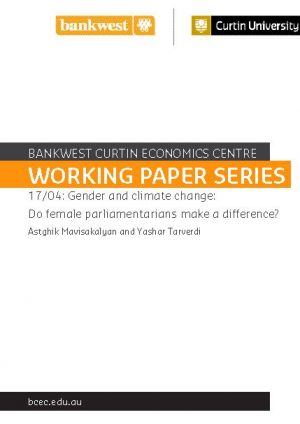 This paper investigates whether female political representation in national parliaments influences climate change policy outcomes. Based on data from a large sample of countries, we demonstrate that female representation leads countries to adopt more stringent climate change policies. We exploit... Read article
This paper investigates whether female political representation in national parliaments influences climate change policy outcomes. Based on data from a large sample of countries, we demonstrate that female representation leads countries to adopt more stringent climate change policies. We exploit... Read article
 This paper investigates whether female political representation in national parliaments influences climate change policy outcomes. Based on data from a large sample of countries, we demonstrate that female representation leads countries to adopt more stringent climate change policies. We exploit... Read article
This paper investigates whether female political representation in national parliaments influences climate change policy outcomes. Based on data from a large sample of countries, we demonstrate that female representation leads countries to adopt more stringent climate change policies. We exploit... Read article
Oil and Women: A Re-examination
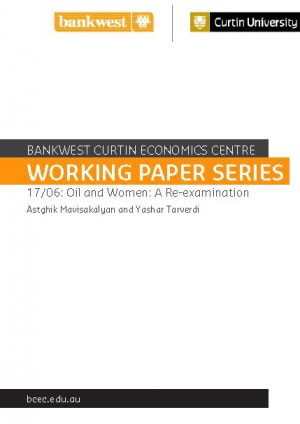 In a seminal article, Ross (2008) reports a negative correlation between oil production and women’s representation in the labour force and politics across countries. This article re-examines these relationships exploiting variations in oil endowments to address endogeneity concerns. We confirm... Read article
In a seminal article, Ross (2008) reports a negative correlation between oil production and women’s representation in the labour force and politics across countries. This article re-examines these relationships exploiting variations in oil endowments to address endogeneity concerns. We confirm... Read article
 In a seminal article, Ross (2008) reports a negative correlation between oil production and women’s representation in the labour force and politics across countries. This article re-examines these relationships exploiting variations in oil endowments to address endogeneity concerns. We confirm... Read article
In a seminal article, Ross (2008) reports a negative correlation between oil production and women’s representation in the labour force and politics across countries. This article re-examines these relationships exploiting variations in oil endowments to address endogeneity concerns. We confirm... Read article
Intra-household entitlements and gender inequality: An Australian perspective
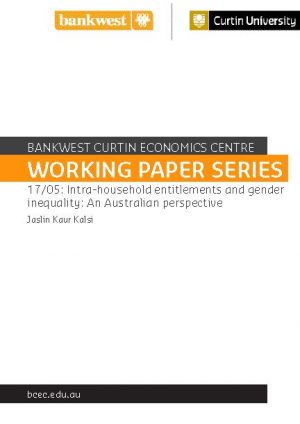 This paper analyses factors which affect the intra-household distribution of entitlements between men and women in Australian couple households. Several studies have been undertaken into the effects of intra-household bargaining on labour, domestic violence, fertility decisions, and wealth. However, Australian... Read article
This paper analyses factors which affect the intra-household distribution of entitlements between men and women in Australian couple households. Several studies have been undertaken into the effects of intra-household bargaining on labour, domestic violence, fertility decisions, and wealth. However, Australian... Read article
 This paper analyses factors which affect the intra-household distribution of entitlements between men and women in Australian couple households. Several studies have been undertaken into the effects of intra-household bargaining on labour, domestic violence, fertility decisions, and wealth. However, Australian... Read article
This paper analyses factors which affect the intra-household distribution of entitlements between men and women in Australian couple households. Several studies have been undertaken into the effects of intra-household bargaining on labour, domestic violence, fertility decisions, and wealth. However, Australian... Read article
Talking in the Present, Caring for the Future: Language and Environment
 This paper identifies a new source that explains environmental behaviour: the presence of future tense marking in language. We predict that languages that grammatically mark the future affect speakers’ intertemporal preferences and thereby reduce their willingness to address climate change.... Read article
This paper identifies a new source that explains environmental behaviour: the presence of future tense marking in language. We predict that languages that grammatically mark the future affect speakers’ intertemporal preferences and thereby reduce their willingness to address climate change.... Read article
 This paper identifies a new source that explains environmental behaviour: the presence of future tense marking in language. We predict that languages that grammatically mark the future affect speakers’ intertemporal preferences and thereby reduce their willingness to address climate change.... Read article
This paper identifies a new source that explains environmental behaviour: the presence of future tense marking in language. We predict that languages that grammatically mark the future affect speakers’ intertemporal preferences and thereby reduce their willingness to address climate change.... Read article
Cost-sharing in health insurance and its impact in a developing country– Evidence from a quasi-natural experiment
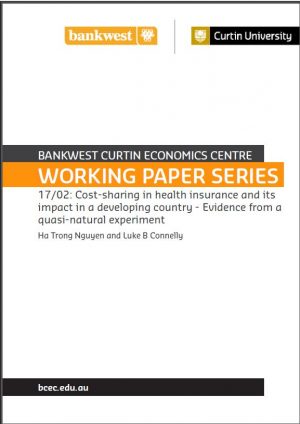 Though the impact of cost-sharing on health care demand is well documented in developed countries, evidence from developing countries is rare. This paper’s contribution is to analyse the impact of increasing coinsurance in a developing nation -Vietnam – by exploiting... Read article
Though the impact of cost-sharing on health care demand is well documented in developed countries, evidence from developing countries is rare. This paper’s contribution is to analyse the impact of increasing coinsurance in a developing nation -Vietnam – by exploiting... Read article
 Though the impact of cost-sharing on health care demand is well documented in developed countries, evidence from developing countries is rare. This paper’s contribution is to analyse the impact of increasing coinsurance in a developing nation -Vietnam – by exploiting... Read article
Though the impact of cost-sharing on health care demand is well documented in developed countries, evidence from developing countries is rare. This paper’s contribution is to analyse the impact of increasing coinsurance in a developing nation -Vietnam – by exploiting... Read article
Culture, housing, remoteness and Aboriginal and Torres Strait Islander child development.
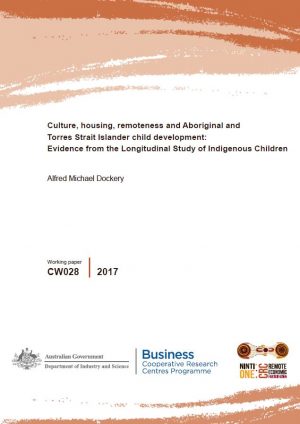 The limited empirical evidence available in Australia points to beneficial effects of Aboriginal and Torres Strait Islander peoples’ identification with their culture across a range of outcome domains. Living in remote communities, with limited mainstream economic opportunity, services and infrastructure... Read article
The limited empirical evidence available in Australia points to beneficial effects of Aboriginal and Torres Strait Islander peoples’ identification with their culture across a range of outcome domains. Living in remote communities, with limited mainstream economic opportunity, services and infrastructure... Read article
 The limited empirical evidence available in Australia points to beneficial effects of Aboriginal and Torres Strait Islander peoples’ identification with their culture across a range of outcome domains. Living in remote communities, with limited mainstream economic opportunity, services and infrastructure... Read article
The limited empirical evidence available in Australia points to beneficial effects of Aboriginal and Torres Strait Islander peoples’ identification with their culture across a range of outcome domains. Living in remote communities, with limited mainstream economic opportunity, services and infrastructure... Read article
The impact of differentiated access to income and wealth on health and wellbeing outcomes: a longitudinal Australian study
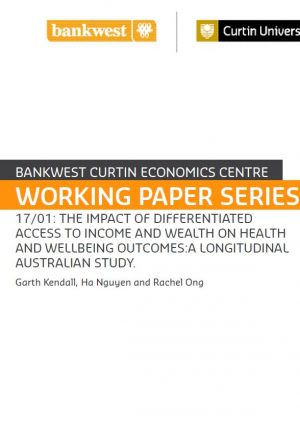 It is very likely that differential access to income and accumulated wealth are both mechanisms that promote growing inequalities between individuals and families in Australia. If this proposition is true, it is important to know the extent to which this... Read article
It is very likely that differential access to income and accumulated wealth are both mechanisms that promote growing inequalities between individuals and families in Australia. If this proposition is true, it is important to know the extent to which this... Read article
 It is very likely that differential access to income and accumulated wealth are both mechanisms that promote growing inequalities between individuals and families in Australia. If this proposition is true, it is important to know the extent to which this... Read article
It is very likely that differential access to income and accumulated wealth are both mechanisms that promote growing inequalities between individuals and families in Australia. If this proposition is true, it is important to know the extent to which this... Read article
Linguistic Relativity and Economics
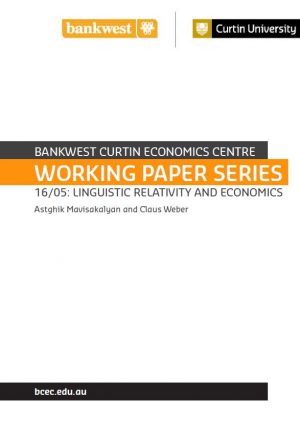 The theory of linguistic relativity—the idea that our language influences our thinking—has a long history in the humanities. Speakers of different languages may systematically think and behave differently. This phenomenon has only recently attracted attention from economists. This paper provides... Read article
The theory of linguistic relativity—the idea that our language influences our thinking—has a long history in the humanities. Speakers of different languages may systematically think and behave differently. This phenomenon has only recently attracted attention from economists. This paper provides... Read article
 The theory of linguistic relativity—the idea that our language influences our thinking—has a long history in the humanities. Speakers of different languages may systematically think and behave differently. This phenomenon has only recently attracted attention from economists. This paper provides... Read article
The theory of linguistic relativity—the idea that our language influences our thinking—has a long history in the humanities. Speakers of different languages may systematically think and behave differently. This phenomenon has only recently attracted attention from economists. This paper provides... Read article
The dynamics of informal care provision in an Australian household panel survey: Previous work characteristics and future care provision
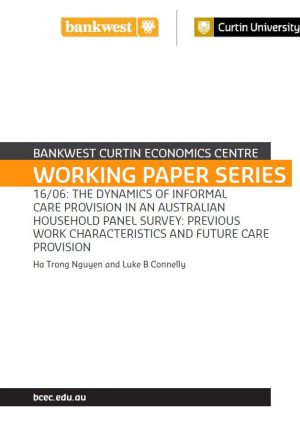 This study contributes to a small literature on the dynamics of informal care by examining the informal care provision choices of working age Australians. We focus on the impact of previous work characteristics (including work security and flexibility) on subsequent... Read article
This study contributes to a small literature on the dynamics of informal care by examining the informal care provision choices of working age Australians. We focus on the impact of previous work characteristics (including work security and flexibility) on subsequent... Read article
 This study contributes to a small literature on the dynamics of informal care by examining the informal care provision choices of working age Australians. We focus on the impact of previous work characteristics (including work security and flexibility) on subsequent... Read article
This study contributes to a small literature on the dynamics of informal care by examining the informal care provision choices of working age Australians. We focus on the impact of previous work characteristics (including work security and flexibility) on subsequent... Read article
Looks matter: Attractiveness and Employment in the Former Soviet Union
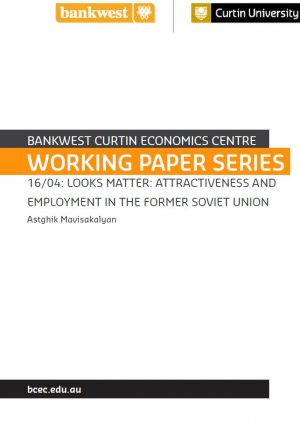 The rigid Soviet policy of full employment ensured employment for all able-bodied population. By removing this policy, the collapse of the system has made discrimination less costly. Has it also become prevalent? This paper studies the labour market discrimination on... Read article
The rigid Soviet policy of full employment ensured employment for all able-bodied population. By removing this policy, the collapse of the system has made discrimination less costly. Has it also become prevalent? This paper studies the labour market discrimination on... Read article
 The rigid Soviet policy of full employment ensured employment for all able-bodied population. By removing this policy, the collapse of the system has made discrimination less costly. Has it also become prevalent? This paper studies the labour market discrimination on... Read article
The rigid Soviet policy of full employment ensured employment for all able-bodied population. By removing this policy, the collapse of the system has made discrimination less costly. Has it also become prevalent? This paper studies the labour market discrimination on... Read article
Self-assessed versus statistical evidence of labour market discrimination
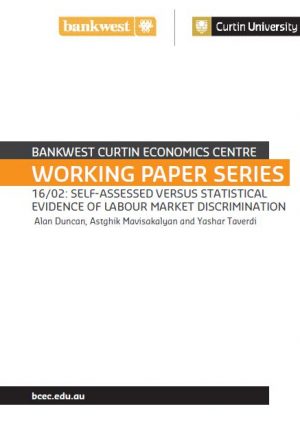 We assess the relative importance of statistical residual-based measures of discrimination in determining indigenous Australians’ perceptions of discrimination in the labour market. We find that statistical measures are largely unrelated to discrimination reports among males and negatively related to discrimination... Read article
We assess the relative importance of statistical residual-based measures of discrimination in determining indigenous Australians’ perceptions of discrimination in the labour market. We find that statistical measures are largely unrelated to discrimination reports among males and negatively related to discrimination... Read article
 We assess the relative importance of statistical residual-based measures of discrimination in determining indigenous Australians’ perceptions of discrimination in the labour market. We find that statistical measures are largely unrelated to discrimination reports among males and negatively related to discrimination... Read article
We assess the relative importance of statistical residual-based measures of discrimination in determining indigenous Australians’ perceptions of discrimination in the labour market. We find that statistical measures are largely unrelated to discrimination reports among males and negatively related to discrimination... Read article
A gendered analysis of age discrimination among older jobseekers in Australia
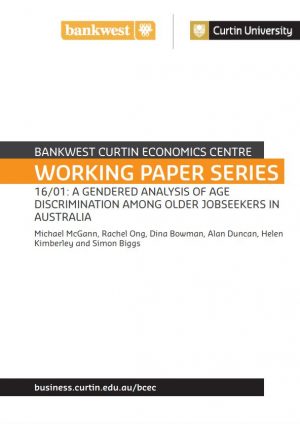 This paper investigates how age and gender interact to shape older jobseekers’ experiences of age discrimination within a mixed methods framework. The analysis reveals that there has been a considerable decline in levels of perceived ageism among older men nationally... Read article
This paper investigates how age and gender interact to shape older jobseekers’ experiences of age discrimination within a mixed methods framework. The analysis reveals that there has been a considerable decline in levels of perceived ageism among older men nationally... Read article
 This paper investigates how age and gender interact to shape older jobseekers’ experiences of age discrimination within a mixed methods framework. The analysis reveals that there has been a considerable decline in levels of perceived ageism among older men nationally... Read article
This paper investigates how age and gender interact to shape older jobseekers’ experiences of age discrimination within a mixed methods framework. The analysis reveals that there has been a considerable decline in levels of perceived ageism among older men nationally... Read article
The efficiency of schools in Australia
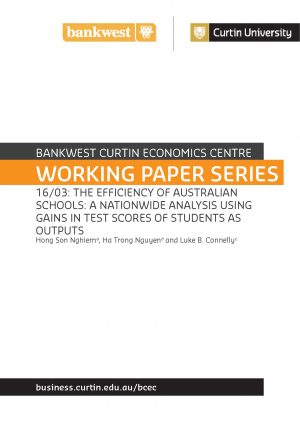 This study examines the efficiency of schools in Australia and its determinants using the gain in NAPLAN test scores of students in 6,774 schools in 2009-2011. The results show that, based on empirical input-output combinations, the growth of NAPLAN test... Read article
This study examines the efficiency of schools in Australia and its determinants using the gain in NAPLAN test scores of students in 6,774 schools in 2009-2011. The results show that, based on empirical input-output combinations, the growth of NAPLAN test... Read article
 This study examines the efficiency of schools in Australia and its determinants using the gain in NAPLAN test scores of students in 6,774 schools in 2009-2011. The results show that, based on empirical input-output combinations, the growth of NAPLAN test... Read article
This study examines the efficiency of schools in Australia and its determinants using the gain in NAPLAN test scores of students in 6,774 schools in 2009-2011. The results show that, based on empirical input-output combinations, the growth of NAPLAN test... Read article
Broadband and economic growth: a re-assessment
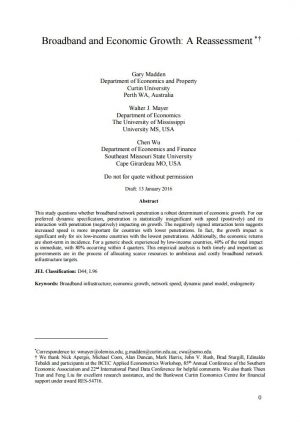 This study questions whether broadband network penetration a robust determinant of economic growth. For our preferred dynamic specification, penetration is statistically insignificant with speed (positively) and its interaction with penetration (negatively) impacting on growth. The negatively signed interaction term suggests... Read article
This study questions whether broadband network penetration a robust determinant of economic growth. For our preferred dynamic specification, penetration is statistically insignificant with speed (positively) and its interaction with penetration (negatively) impacting on growth. The negatively signed interaction term suggests... Read article
 This study questions whether broadband network penetration a robust determinant of economic growth. For our preferred dynamic specification, penetration is statistically insignificant with speed (positively) and its interaction with penetration (negatively) impacting on growth. The negatively signed interaction term suggests... Read article
This study questions whether broadband network penetration a robust determinant of economic growth. For our preferred dynamic specification, penetration is statistically insignificant with speed (positively) and its interaction with penetration (negatively) impacting on growth. The negatively signed interaction term suggests... Read article
The impact of maternal mental health shocks on child health
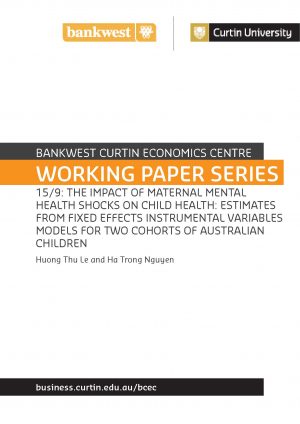 This paper contributes to an emerging body of literature on intergenerational transmission in health by presenting the first causal estimates on the impact of maternal mental health shocks on child health. The potential endogeneity of maternal mental health shocks is... Read article
This paper contributes to an emerging body of literature on intergenerational transmission in health by presenting the first causal estimates on the impact of maternal mental health shocks on child health. The potential endogeneity of maternal mental health shocks is... Read article
 This paper contributes to an emerging body of literature on intergenerational transmission in health by presenting the first causal estimates on the impact of maternal mental health shocks on child health. The potential endogeneity of maternal mental health shocks is... Read article
This paper contributes to an emerging body of literature on intergenerational transmission in health by presenting the first causal estimates on the impact of maternal mental health shocks on child health. The potential endogeneity of maternal mental health shocks is... Read article
Occupational segregation and women’s job satisfaction
 Data on men and women’s job satisfaction conditional upon the degree of feminisation of their occupation are used to explore potential causes and implications of occupational segregation by gender in the Australian labour market. We find some evidence for the... Read article
Data on men and women’s job satisfaction conditional upon the degree of feminisation of their occupation are used to explore potential causes and implications of occupational segregation by gender in the Australian labour market. We find some evidence for the... Read article
 Data on men and women’s job satisfaction conditional upon the degree of feminisation of their occupation are used to explore potential causes and implications of occupational segregation by gender in the Australian labour market. We find some evidence for the... Read article
Data on men and women’s job satisfaction conditional upon the degree of feminisation of their occupation are used to explore potential causes and implications of occupational segregation by gender in the Australian labour market. We find some evidence for the... Read article
Survey self-assessments, reporting behaviour and the use of externally collected vignettes
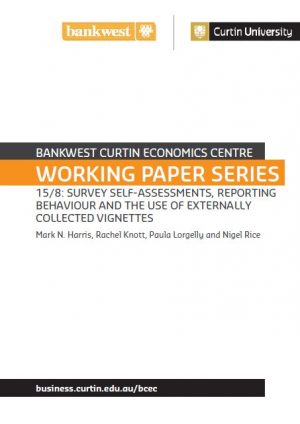 The anchoring vignette approach has grown in popularity as a method to adjust for reporting heterogeneity in subjective self-reports, removing bias due to systematic variation in reporting styles across study respondents. The use of anchoring vignettes, however, has been limited to surveys where... Read article
The anchoring vignette approach has grown in popularity as a method to adjust for reporting heterogeneity in subjective self-reports, removing bias due to systematic variation in reporting styles across study respondents. The use of anchoring vignettes, however, has been limited to surveys where... Read article
 The anchoring vignette approach has grown in popularity as a method to adjust for reporting heterogeneity in subjective self-reports, removing bias due to systematic variation in reporting styles across study respondents. The use of anchoring vignettes, however, has been limited to surveys where... Read article
The anchoring vignette approach has grown in popularity as a method to adjust for reporting heterogeneity in subjective self-reports, removing bias due to systematic variation in reporting styles across study respondents. The use of anchoring vignettes, however, has been limited to surveys where... Read article
The evolution of the gender test score gap through seventh grade
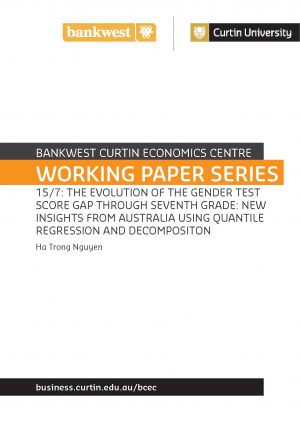 This paper documents the patterns and examines the factors contributing to a gender test score gap in five test subjects in early seventh grade of schooling using a recent and nationally representative panel of Australian children. Regression results indicate that... Read article
This paper documents the patterns and examines the factors contributing to a gender test score gap in five test subjects in early seventh grade of schooling using a recent and nationally representative panel of Australian children. Regression results indicate that... Read article
 This paper documents the patterns and examines the factors contributing to a gender test score gap in five test subjects in early seventh grade of schooling using a recent and nationally representative panel of Australian children. Regression results indicate that... Read article
This paper documents the patterns and examines the factors contributing to a gender test score gap in five test subjects in early seventh grade of schooling using a recent and nationally representative panel of Australian children. Regression results indicate that... Read article
Parental health and children’s cognitive and non-cognitive development
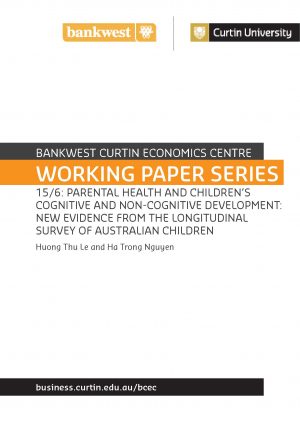 This paper examines the effects of maternal and paternal health on cognitive and non-cognitive development in Australian children. The underlying nationally representative panel data and a child fixed effects estimator are used to overcome most of the previous cross-sectional study... Read article
This paper examines the effects of maternal and paternal health on cognitive and non-cognitive development in Australian children. The underlying nationally representative panel data and a child fixed effects estimator are used to overcome most of the previous cross-sectional study... Read article
 This paper examines the effects of maternal and paternal health on cognitive and non-cognitive development in Australian children. The underlying nationally representative panel data and a child fixed effects estimator are used to overcome most of the previous cross-sectional study... Read article
This paper examines the effects of maternal and paternal health on cognitive and non-cognitive development in Australian children. The underlying nationally representative panel data and a child fixed effects estimator are used to overcome most of the previous cross-sectional study... Read article
The use of home equity to fund the consumption needs of retirees
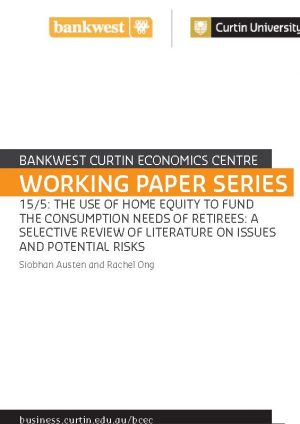 This paper identifies the broad issues associated with the use of home equity to fund the consumption needs of retirees by reviewing the relevant international literature. The specific literature that examines the role of home equity in the retirement income... Read article
This paper identifies the broad issues associated with the use of home equity to fund the consumption needs of retirees by reviewing the relevant international literature. The specific literature that examines the role of home equity in the retirement income... Read article
 This paper identifies the broad issues associated with the use of home equity to fund the consumption needs of retirees by reviewing the relevant international literature. The specific literature that examines the role of home equity in the retirement income... Read article
This paper identifies the broad issues associated with the use of home equity to fund the consumption needs of retirees by reviewing the relevant international literature. The specific literature that examines the role of home equity in the retirement income... Read article
When Two Worlds Collude
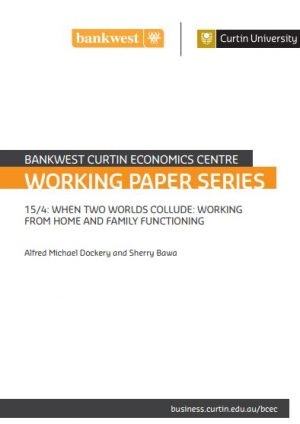 Whether or not working from home or ‘telecommuting’ helps workers to balance work and family commitments, as opposed to providing an avenue for work to intrude on family life remains a contentious issue. On balance it seems the flexibility to... Read article
Whether or not working from home or ‘telecommuting’ helps workers to balance work and family commitments, as opposed to providing an avenue for work to intrude on family life remains a contentious issue. On balance it seems the flexibility to... Read article
 Whether or not working from home or ‘telecommuting’ helps workers to balance work and family commitments, as opposed to providing an avenue for work to intrude on family life remains a contentious issue. On balance it seems the flexibility to... Read article
Whether or not working from home or ‘telecommuting’ helps workers to balance work and family commitments, as opposed to providing an avenue for work to intrude on family life remains a contentious issue. On balance it seems the flexibility to... Read article
Exchange rate fluctuations and immigrants’ labour market outcomes
 In this paper, we exploit exogenous changes in exchange rates across home countries over time and panel data to identify the casual impact of exchange rate fluctuations on Australian immigrants’ labour market outcomes. We present new and robust evidence that,... Read article
In this paper, we exploit exogenous changes in exchange rates across home countries over time and panel data to identify the casual impact of exchange rate fluctuations on Australian immigrants’ labour market outcomes. We present new and robust evidence that,... Read article
 In this paper, we exploit exogenous changes in exchange rates across home countries over time and panel data to identify the casual impact of exchange rate fluctuations on Australian immigrants’ labour market outcomes. We present new and robust evidence that,... Read article
In this paper, we exploit exogenous changes in exchange rates across home countries over time and panel data to identify the casual impact of exchange rate fluctuations on Australian immigrants’ labour market outcomes. We present new and robust evidence that,... Read article
Macroeconomic Fluctuations in Home Countries and Immigrants’ Wellbeing
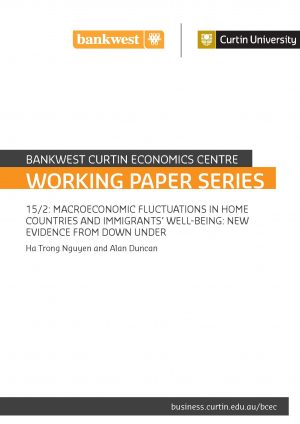 In this paper we provide the first solid empirical evidence that improvements in home countries’ macroeconomic conditions, as measured by a higher GDP per capita and lower price levels, increase immigrants’ subjective well-being. We demonstrate this using 12 years of... Read article
In this paper we provide the first solid empirical evidence that improvements in home countries’ macroeconomic conditions, as measured by a higher GDP per capita and lower price levels, increase immigrants’ subjective well-being. We demonstrate this using 12 years of... Read article
 In this paper we provide the first solid empirical evidence that improvements in home countries’ macroeconomic conditions, as measured by a higher GDP per capita and lower price levels, increase immigrants’ subjective well-being. We demonstrate this using 12 years of... Read article
In this paper we provide the first solid empirical evidence that improvements in home countries’ macroeconomic conditions, as measured by a higher GDP per capita and lower price levels, increase immigrants’ subjective well-being. We demonstrate this using 12 years of... Read article
Macroeconomic Fluctuations in Home Countries and Immigrant’s Well-being
 Abstract In this paper we provide the first solid empirical evidence that improvements in home countries’ macroeconomic conditions, as measured by a higher GDP per capita and lower price levels, increase immigrants’ subjective well-being. We demonstrate this using 12 years... Read article
Abstract In this paper we provide the first solid empirical evidence that improvements in home countries’ macroeconomic conditions, as measured by a higher GDP per capita and lower price levels, increase immigrants’ subjective well-being. We demonstrate this using 12 years... Read article
 Abstract In this paper we provide the first solid empirical evidence that improvements in home countries’ macroeconomic conditions, as measured by a higher GDP per capita and lower price levels, increase immigrants’ subjective well-being. We demonstrate this using 12 years... Read article
Abstract In this paper we provide the first solid empirical evidence that improvements in home countries’ macroeconomic conditions, as measured by a higher GDP per capita and lower price levels, increase immigrants’ subjective well-being. We demonstrate this using 12 years... Read article
Pharmaceutical Drug Misuse, Industry of Employment and Occupation
 Abstract We contribute to the existing literature on drug consumption by analysing the misuse of pharmaceutical drugs, which has attracted scant attention in the economics literature. Specifically, using individual level data, we explore the determinants of pharmaceutical drug misuse and... Read article
Abstract We contribute to the existing literature on drug consumption by analysing the misuse of pharmaceutical drugs, which has attracted scant attention in the economics literature. Specifically, using individual level data, we explore the determinants of pharmaceutical drug misuse and... Read article
 Abstract We contribute to the existing literature on drug consumption by analysing the misuse of pharmaceutical drugs, which has attracted scant attention in the economics literature. Specifically, using individual level data, we explore the determinants of pharmaceutical drug misuse and... Read article
Abstract We contribute to the existing literature on drug consumption by analysing the misuse of pharmaceutical drugs, which has attracted scant attention in the economics literature. Specifically, using individual level data, we explore the determinants of pharmaceutical drug misuse and... Read article
Housing Equity Withdrawal in mid-to-late life: Patterns and Motivations amongst Australian Homeowners
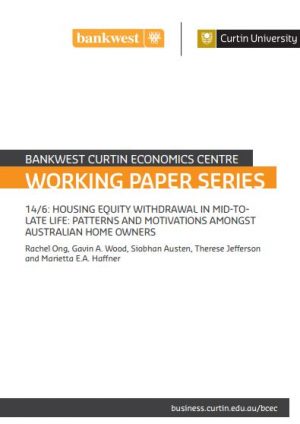 Abstract In an era of population ageing, the primary home is increasingly viewed as a personal resource that can perform a pension role in retirement. This paper assesses the extent to which Australians aged over 45 utilise housing equity withdrawal... Read article
Abstract In an era of population ageing, the primary home is increasingly viewed as a personal resource that can perform a pension role in retirement. This paper assesses the extent to which Australians aged over 45 utilise housing equity withdrawal... Read article
 Abstract In an era of population ageing, the primary home is increasingly viewed as a personal resource that can perform a pension role in retirement. This paper assesses the extent to which Australians aged over 45 utilise housing equity withdrawal... Read article
Abstract In an era of population ageing, the primary home is increasingly viewed as a personal resource that can perform a pension role in retirement. This paper assesses the extent to which Australians aged over 45 utilise housing equity withdrawal... Read article
A Multi-Market Approach to Measuring the Cycle
 At any given moment there are numerous indicators of the state of an economy or sector. Frequently, these signals are divergent, for example, some may point to an expansion, while others to a contraction. We consider how best to combine... Read article
At any given moment there are numerous indicators of the state of an economy or sector. Frequently, these signals are divergent, for example, some may point to an expansion, while others to a contraction. We consider how best to combine... Read article
 At any given moment there are numerous indicators of the state of an economy or sector. Frequently, these signals are divergent, for example, some may point to an expansion, while others to a contraction. We consider how best to combine... Read article
At any given moment there are numerous indicators of the state of an economy or sector. Frequently, these signals are divergent, for example, some may point to an expansion, while others to a contraction. We consider how best to combine... Read article
Modelling Financial Satisfaction across Life Stages
 Abstract We explore the determinants of
financial satisfaction using a modelling framework which allows the drivers of fi
nancial satisfaction to vary across life stages. Given that fi
nancial satisfaction is measured as an ordered variable, our modelling approach is based on... Read article
Abstract We explore the determinants of
financial satisfaction using a modelling framework which allows the drivers of fi
nancial satisfaction to vary across life stages. Given that fi
nancial satisfaction is measured as an ordered variable, our modelling approach is based on... Read article
 Abstract We explore the determinants of
financial satisfaction using a modelling framework which allows the drivers of fi
nancial satisfaction to vary across life stages. Given that fi
nancial satisfaction is measured as an ordered variable, our modelling approach is based on... Read article
Abstract We explore the determinants of
financial satisfaction using a modelling framework which allows the drivers of fi
nancial satisfaction to vary across life stages. Given that fi
nancial satisfaction is measured as an ordered variable, our modelling approach is based on... Read article
A Regional Framework for Analysing the Western Australian Economy
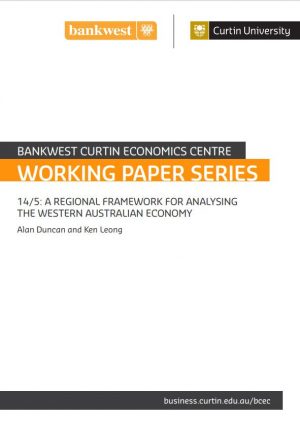 Western Australia is a diverse state with unique regions. Studies on the economy that adopt a ‘one size fits all’ approach are likely to be hindered by a lack of the richness and variability inherent in the intra-state regions. This... Read article
Western Australia is a diverse state with unique regions. Studies on the economy that adopt a ‘one size fits all’ approach are likely to be hindered by a lack of the richness and variability inherent in the intra-state regions. This... Read article
 Western Australia is a diverse state with unique regions. Studies on the economy that adopt a ‘one size fits all’ approach are likely to be hindered by a lack of the richness and variability inherent in the intra-state regions. This... Read article
Western Australia is a diverse state with unique regions. Studies on the economy that adopt a ‘one size fits all’ approach are likely to be hindered by a lack of the richness and variability inherent in the intra-state regions. This... Read article
Is Working From Home Good Work or Bad Work?
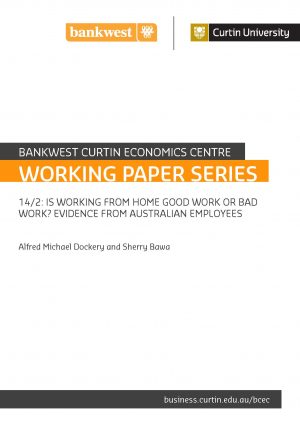 There is concern that workers are finding it increasingly difficult to balance work and family life and face growing time stress. Working from home is one form of flexibility in working arrangements that may assist workers to juggle work and... Read article
There is concern that workers are finding it increasingly difficult to balance work and family life and face growing time stress. Working from home is one form of flexibility in working arrangements that may assist workers to juggle work and... Read article
 There is concern that workers are finding it increasingly difficult to balance work and family life and face growing time stress. Working from home is one form of flexibility in working arrangements that may assist workers to juggle work and... Read article
There is concern that workers are finding it increasingly difficult to balance work and family life and face growing time stress. Working from home is one form of flexibility in working arrangements that may assist workers to juggle work and... Read article
A Zero Inflated Regression Model for Grouped Data
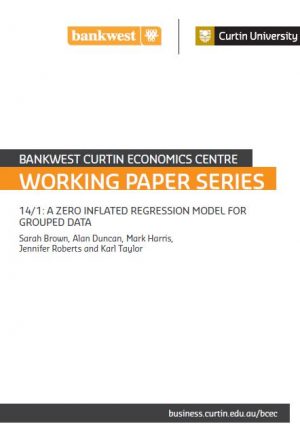 We introduce the (panel) zero-inflated interval regression (ZIIR) model, which is ideally suited when data are in the form of groups, which is commonly the case in survey data, and there is an ‘excess’ of zero observations. We apply our... Read article
We introduce the (panel) zero-inflated interval regression (ZIIR) model, which is ideally suited when data are in the form of groups, which is commonly the case in survey data, and there is an ‘excess’ of zero observations. We apply our... Read article
 We introduce the (panel) zero-inflated interval regression (ZIIR) model, which is ideally suited when data are in the form of groups, which is commonly the case in survey data, and there is an ‘excess’ of zero observations. We apply our... Read article
We introduce the (panel) zero-inflated interval regression (ZIIR) model, which is ideally suited when data are in the form of groups, which is commonly the case in survey data, and there is an ‘excess’ of zero observations. We apply our... Read article
Alternative Methods of Estimating Interaction Effects in Non-Linear Models
 Introduction This paper reviews alternative methods for estimating interaction effects in non-linear models. Interaction effects refer to the way in which the relationship between two variables can differ between categories of a third variable. Many researchers attempt to measure interaction effects, understanding that... Read article
Introduction This paper reviews alternative methods for estimating interaction effects in non-linear models. Interaction effects refer to the way in which the relationship between two variables can differ between categories of a third variable. Many researchers attempt to measure interaction effects, understanding that... Read article
 Introduction This paper reviews alternative methods for estimating interaction effects in non-linear models. Interaction effects refer to the way in which the relationship between two variables can differ between categories of a third variable. Many researchers attempt to measure interaction effects, understanding that... Read article
Introduction This paper reviews alternative methods for estimating interaction effects in non-linear models. Interaction effects refer to the way in which the relationship between two variables can differ between categories of a third variable. Many researchers attempt to measure interaction effects, understanding that... Read article
Work Incentives and Decisions to Remain in Paid Work in Australia
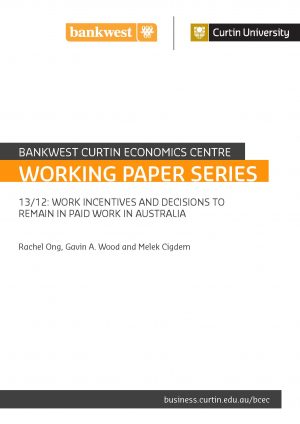 Introduction Lifting workforce participation rates is a key objective of Australian policy-makers. The most recent evidence of this emerged in the lead up to the 2013 Federal election. The Coalition proposed that young Australians unemployed for 12 months or more and receiving... Read article
Introduction Lifting workforce participation rates is a key objective of Australian policy-makers. The most recent evidence of this emerged in the lead up to the 2013 Federal election. The Coalition proposed that young Australians unemployed for 12 months or more and receiving... Read article
 Introduction Lifting workforce participation rates is a key objective of Australian policy-makers. The most recent evidence of this emerged in the lead up to the 2013 Federal election. The Coalition proposed that young Australians unemployed for 12 months or more and receiving... Read article
Introduction Lifting workforce participation rates is a key objective of Australian policy-makers. The most recent evidence of this emerged in the lead up to the 2013 Federal election. The Coalition proposed that young Australians unemployed for 12 months or more and receiving... Read article
Elder Care and the Employment Intentions of Mature Age Women
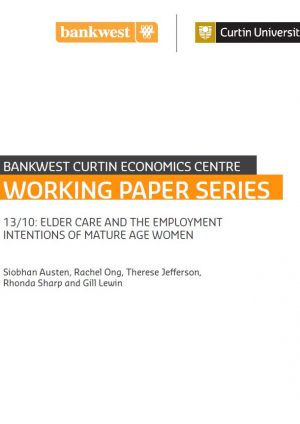 Introduction This paper addresses the employment impacts of eldercare, which we define as the informal, uncompensated care provided to elderly people. This unpaid work is a vital component of the ‘care economy’ that utilises time, emotional and other resources of... Read article
Introduction This paper addresses the employment impacts of eldercare, which we define as the informal, uncompensated care provided to elderly people. This unpaid work is a vital component of the ‘care economy’ that utilises time, emotional and other resources of... Read article
 Introduction This paper addresses the employment impacts of eldercare, which we define as the informal, uncompensated care provided to elderly people. This unpaid work is a vital component of the ‘care economy’ that utilises time, emotional and other resources of... Read article
Introduction This paper addresses the employment impacts of eldercare, which we define as the informal, uncompensated care provided to elderly people. This unpaid work is a vital component of the ‘care economy’ that utilises time, emotional and other resources of... Read article
Estimating the Standard Errors of Individual-Specific Parameters in Random Parameters Models
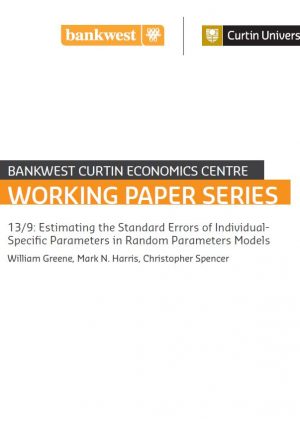 Abstract We consider the estimation of the standard errors of individual‐specific parameters calculated ex post from a non‐linear random parameters model. Our key contribution lies in introducing a simple method of appropriately calculating these standard errors, which explicitly takes into account the sampling variability... Read article
Abstract We consider the estimation of the standard errors of individual‐specific parameters calculated ex post from a non‐linear random parameters model. Our key contribution lies in introducing a simple method of appropriately calculating these standard errors, which explicitly takes into account the sampling variability... Read article
 Abstract We consider the estimation of the standard errors of individual‐specific parameters calculated ex post from a non‐linear random parameters model. Our key contribution lies in introducing a simple method of appropriately calculating these standard errors, which explicitly takes into account the sampling variability... Read article
Abstract We consider the estimation of the standard errors of individual‐specific parameters calculated ex post from a non‐linear random parameters model. Our key contribution lies in introducing a simple method of appropriately calculating these standard errors, which explicitly takes into account the sampling variability... Read article
Trends in the Gender Wealth Gap Among Single Households in Australia 2002-2010
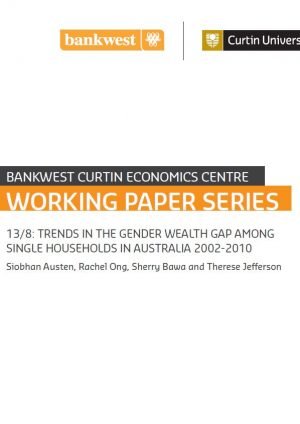 Abstract This study uses three wealth modules from the Household, Income and Labour Dynamics in Australia Survey to explore the gender wealth gap for single Australian households between 2002 and 2010. The findings indicate significant gender wealth gaps, which have increased over the... Read article
Abstract This study uses three wealth modules from the Household, Income and Labour Dynamics in Australia Survey to explore the gender wealth gap for single Australian households between 2002 and 2010. The findings indicate significant gender wealth gaps, which have increased over the... Read article
 Abstract This study uses three wealth modules from the Household, Income and Labour Dynamics in Australia Survey to explore the gender wealth gap for single Australian households between 2002 and 2010. The findings indicate significant gender wealth gaps, which have increased over the... Read article
Abstract This study uses three wealth modules from the Household, Income and Labour Dynamics in Australia Survey to explore the gender wealth gap for single Australian households between 2002 and 2010. The findings indicate significant gender wealth gaps, which have increased over the... Read article
The Influence of Psychological Well-Being, Ill-Health and Health Shocks on Single Parents’ Labour Supply
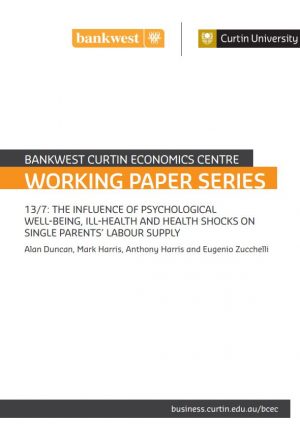 This paper proposes a discrete-choice behavioural model of labour supply to examine the role of ill-health on single parents’ employment. The model provides estimates of individual preferences over a given set of labour market states and allows these preferences to be influenced by... Read article
This paper proposes a discrete-choice behavioural model of labour supply to examine the role of ill-health on single parents’ employment. The model provides estimates of individual preferences over a given set of labour market states and allows these preferences to be influenced by... Read article
 This paper proposes a discrete-choice behavioural model of labour supply to examine the role of ill-health on single parents’ employment. The model provides estimates of individual preferences over a given set of labour market states and allows these preferences to be influenced by... Read article
This paper proposes a discrete-choice behavioural model of labour supply to examine the role of ill-health on single parents’ employment. The model provides estimates of individual preferences over a given set of labour market states and allows these preferences to be influenced by... Read article
Advantages of Non-Normality in Testing Cointegration Rank
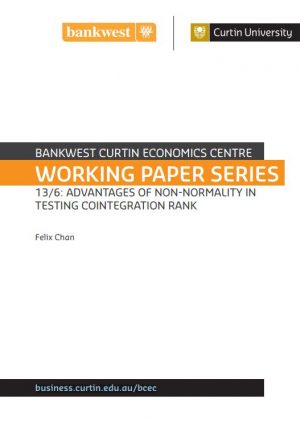 Abstract Since the seminal work of Engle and Granger (1987) and Johansen (1988), testing for cointegration has become standard practice in analysing economic and financial time series data. Many of the techniques in cointegration analysis require the assumption of normality, which may... Read article
Abstract Since the seminal work of Engle and Granger (1987) and Johansen (1988), testing for cointegration has become standard practice in analysing economic and financial time series data. Many of the techniques in cointegration analysis require the assumption of normality, which may... Read article
 Abstract Since the seminal work of Engle and Granger (1987) and Johansen (1988), testing for cointegration has become standard practice in analysing economic and financial time series data. Many of the techniques in cointegration analysis require the assumption of normality, which may... Read article
Abstract Since the seminal work of Engle and Granger (1987) and Johansen (1988), testing for cointegration has become standard practice in analysing economic and financial time series data. Many of the techniques in cointegration analysis require the assumption of normality, which may... Read article
Econometric Modelling of Social Bads
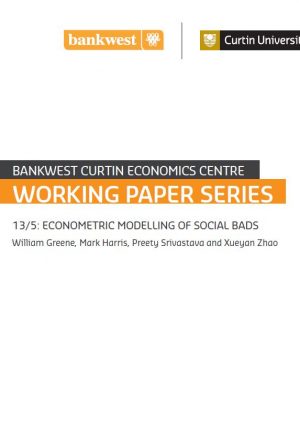 Abstract When modeling “social bads”, such as illegal drug consumption, researchers are often faced with a dependent variable characterised by an “excessive” amount of zero observations. Building on the recent literature on hurdle and double-hurdle models, we propose a double-inflated modeling framework, where the... Read article
Abstract When modeling “social bads”, such as illegal drug consumption, researchers are often faced with a dependent variable characterised by an “excessive” amount of zero observations. Building on the recent literature on hurdle and double-hurdle models, we propose a double-inflated modeling framework, where the... Read article
 Abstract When modeling “social bads”, such as illegal drug consumption, researchers are often faced with a dependent variable characterised by an “excessive” amount of zero observations. Building on the recent literature on hurdle and double-hurdle models, we propose a double-inflated modeling framework, where the... Read article
Abstract When modeling “social bads”, such as illegal drug consumption, researchers are often faced with a dependent variable characterised by an “excessive” amount of zero observations. Building on the recent literature on hurdle and double-hurdle models, we propose a double-inflated modeling framework, where the... Read article
Brain Drain or Brawn Drain?
 Studies on the determinants of migration provide evidence that distance has a strong negative effect. That is, the farther the region is, the lower the probability that people would like to migrate to. However, Western Australia, whose capital city is... Read article
Studies on the determinants of migration provide evidence that distance has a strong negative effect. That is, the farther the region is, the lower the probability that people would like to migrate to. However, Western Australia, whose capital city is... Read article
 Studies on the determinants of migration provide evidence that distance has a strong negative effect. That is, the farther the region is, the lower the probability that people would like to migrate to. However, Western Australia, whose capital city is... Read article
Studies on the determinants of migration provide evidence that distance has a strong negative effect. That is, the farther the region is, the lower the probability that people would like to migrate to. However, Western Australia, whose capital city is... Read article
Modelling Illegal Drug Participation in Australia
 Abstract We contribute to the small, but important, literature exploring the incidence and implications of mis-reporting in survey data. Specifically, when modelling “social bads”, such as illegal drug consumption, researchers are often faced with exceptionally low reported participation rates. We propose a... Read article
Abstract We contribute to the small, but important, literature exploring the incidence and implications of mis-reporting in survey data. Specifically, when modelling “social bads”, such as illegal drug consumption, researchers are often faced with exceptionally low reported participation rates. We propose a... Read article
 Abstract We contribute to the small, but important, literature exploring the incidence and implications of mis-reporting in survey data. Specifically, when modelling “social bads”, such as illegal drug consumption, researchers are often faced with exceptionally low reported participation rates. We propose a... Read article
Abstract We contribute to the small, but important, literature exploring the incidence and implications of mis-reporting in survey data. Specifically, when modelling “social bads”, such as illegal drug consumption, researchers are often faced with exceptionally low reported participation rates. We propose a... Read article
Underemployment among mature age workers in Australia
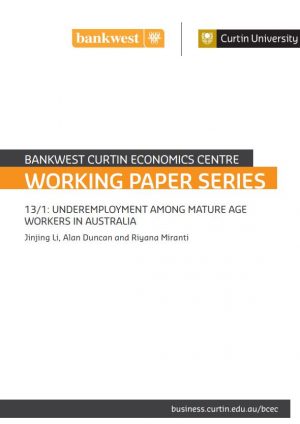 Underemployment is a serious and pervasive problem both in terms of its impact on those individuals affected, and for the economy as a whole. International research has found that those who experience periods of underemployment are more likely to have... Read article
Underemployment is a serious and pervasive problem both in terms of its impact on those individuals affected, and for the economy as a whole. International research has found that those who experience periods of underemployment are more likely to have... Read article
 Underemployment is a serious and pervasive problem both in terms of its impact on those individuals affected, and for the economy as a whole. International research has found that those who experience periods of underemployment are more likely to have... Read article
Underemployment is a serious and pervasive problem both in terms of its impact on those individuals affected, and for the economy as a whole. International research has found that those who experience periods of underemployment are more likely to have... Read article
The Impact of Children on Australian Couples’ Wealth Accumulation
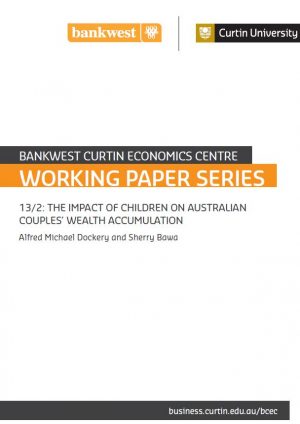 Abstract Existing estimates of the cost of raising children mainly focus on what parents spend on their children. This paper challenges the conceptual basis for this approach, and instead investigates how the presence of children impacts upon couples’ wealth accumulation using the life-cycle... Read article
Abstract Existing estimates of the cost of raising children mainly focus on what parents spend on their children. This paper challenges the conceptual basis for this approach, and instead investigates how the presence of children impacts upon couples’ wealth accumulation using the life-cycle... Read article
 Abstract Existing estimates of the cost of raising children mainly focus on what parents spend on their children. This paper challenges the conceptual basis for this approach, and instead investigates how the presence of children impacts upon couples’ wealth accumulation using the life-cycle... Read article
Abstract Existing estimates of the cost of raising children mainly focus on what parents spend on their children. This paper challenges the conceptual basis for this approach, and instead investigates how the presence of children impacts upon couples’ wealth accumulation using the life-cycle... Read article

